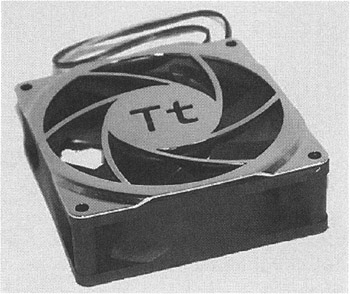Ventilation within the Case
|
| < Day Day Up > |
|
The main task of ventilation in the computer case is decreasing the interior temperature. This is achieved by installing additional fans that ensure an additional flow of cool air into the computer case or that push hot air from it. Because the PC case is not hermetically sealed, the temperature within the case always will decrease as hot air flows out of the case and cool air flows in. For efficient ventilation of the computer case, the correct number and location of the fans must be chosen, and the direction of the airflows created by those fans must be calculated.
The most common additional system unit fans have dimensions of 80 × 80 × 25 mm, although 90 mm or 60 mm fans can be encountered. As a rule, they lack brand names — for example, System Fan ATX 80mm. It is better to purchase retail versions, which will give the fan characteristics and will supply small ironware elements for fastening the cooler to the case, as well as a PC-Plug adapter (if the fan has Molex connector).
Recently, fans with automatic control of the rotation speed have become popular. In these fans, the rotation speed is based on the temperature of the ambient air. When the workload is low (as in the Sleep mode), the temperature of the air within the case is also low, and the fan rotates at the minimal speed. As the workload increases, the temperature within the case also rises, which increases the fan rotation speed. An example of such fan is the Thermaltake Smart Case Fan (Fig. 10.26). It has dimensions of 80 × 80 × 25 mm, and the rotation speed, depending on the temperature, varies from 3,000 rpm to 5,000 rpm. The minimum rotation speed is achieved at 27°C (81°F); the maximum speed is reached at 47°C (117°F).

Figure 10.26: System cooler from Thermaltake
|
| < Day Day Up > |
|
EAN: 2147483647
Pages: 111